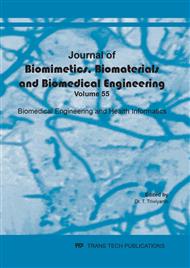[1]
United Nations ESCAP, Making It Happen: Technology, Finance And Statistics for Sustainable Development in Asia and the Pacific,, (2015).
Google Scholar
[2]
A. Quay, Telemedicine System Using Voice Video and Data Encapsulation and De-Encapsulation for Communicating Medical Information between Central Monitoring Stations and Remote Patient Monitoring Stations,, United States Pat., no. 5,987,519, (1999).
Google Scholar
[3]
S. M. Ahmed and O. Elnahas, A Wireless Emergency Telemedicine System for Patients Monitoring and Diagnosis,, vol. 2014, (2014).
Google Scholar
[4]
Y. Jasemian and L. Arendt-nielsen, Evaluation of a realtime , remote monitoring telemedicine system using the Bluetooth protocol and a mobile phone network,, no. February, 2005,.
DOI: 10.1258/1357633054471911
Google Scholar
[5]
J. Yousef and A. N. Lars, Validation of a real-time wireless telemedicine system, using bluetooth protocol and a mobile phone, for remote monitoring patient on medical practice,, Eur. J. Med. Res., vol. 10, no. 6, p.254–262, (2005).
Google Scholar
[6]
G. Miller, The Smartphone Psychology Manifesto,, Perspect. Psychol. Sci., vol. 7, no. 3, p.221–237, 2012,.
Google Scholar
[7]
A. I. Dumitru and G. L. Mogan, Driver warning assistant for monitoring heart rate and SpO2 using mobile phones,, Appl. Mech. Mater., vol. 656, p.395–402, 2014,.
DOI: 10.4028/www.scientific.net/amm.656.395
Google Scholar
[8]
J. Wang and Z. H. Fan, Family health telemonitoring system based on WSN,, Adv. Mater. Res., vol. 860–863, p.2762–2765, 2014,.
DOI: 10.4028/www.scientific.net/amr.860-863.2762
Google Scholar
[9]
A. I. Dumitru, G. L. Mogan, and L. Jalbă, Personalized Calibration of Heart Rate and SpO2 Using Smartphones as Driver Assistant,, Appl. Mech. Mater., vol. 772, p.591–596, 2015,.
DOI: 10.4028/www.scientific.net/amm.772.591
Google Scholar
[10]
B. Utomo, E. D. Setioningsih, and T. Hamzah, Oximeter and BPM on Smartwatch Device Using Mit-App Android with Abnormality Alarm,, J. Electron. Electromed. Med. Informatics, vol. 3, no. 2, p.85–92, (2021).
DOI: 10.35882/jeeemi.v3i2.4
Google Scholar
[11]
M. A. Pertiwi, I. D. Gede, H. Wisana, and S. Sukaphat, Measurement of Heart Rate and Body Temperature Based on Android Platform,, Indones. J. Electron. Electromed. Med. Informatics, vol. 2, no. 1, p.26–33, 2020,.
DOI: 10.35882/ijeeemi.v2i1.6
Google Scholar
[12]
S.-S. Oak and P. Aroul, How to Design Peripheral Oxygen Saturation (SpO2) and Optical Heart Rate Monitoring (OHRM) Systems Using the AFE4403,, Texas Instruments - Appl. Rep., no. March, p.1–7, (2015).
Google Scholar
[13]
Z. Q. He, W. Xu, and G. X. Liu, Design of a wireless medical monitoring system,, 2011 Int. Conf. Comput. Manag. CAMAN 2011, p.1–3, 2011,.
Google Scholar
[14]
Z. Hu, S. Li, and D. Li, SpO2 detecting applied on android platform,, Appl. Mech. Mater., vol. 303–306, p.659–662, 2013,.
Google Scholar
[15]
M. Rostami and A. Janghorbani, Design and implementation of telemedicine system for Spo2 monitoring,, 22nd Iran. Conf. Electr. Eng. ICEE 2014, no. Icee, p.1945–1949, 2014,.
DOI: 10.1109/iraniancee.2014.6999860
Google Scholar
[16]
R. Fensli, T. Gundersen, T. Snaprud, and O. Hejlesen, Clinical evaluation of a wireless ECG sensor system for arrhythmia diagnostic purposes,, Med. Eng. Phys., vol. 35, no. 6, p.697–703, 2013, doi: https://doi.org/10.1016/j.medengphy.2013.03.002.
DOI: 10.1016/j.medengphy.2013.03.002
Google Scholar
[17]
S. Misra and S. Chatterjee, Social choice considerations in cloud-assisted WBAN architecture for post-disaster healthcare: Data aggregation and channelization,, Inf. Sci., vol. 284, p.95–117, (2014).
DOI: 10.1016/j.ins.2014.05.010
Google Scholar
[18]
I. D. G. H. Wisana, P. C. Nugraha, and D. Estiwidani, Design Oxygen Saturation Monitoring in Telemedicine Smartphone System (TmSS),, Int. J. Comput. Appl., vol. 174, no. 17, p.42–45, 2021,.
DOI: 10.5120/ijca2021921062
Google Scholar
[19]
B. Sangeeta and S. Laxmi, A Real Time Analysis of PPG Signal for Measurement of SpO2 and Pulse Rate,, Int. J. Comput. Appl., vol. 36, no. 11, p.45–50, (2011).
Google Scholar
[20]
I. M. Alhyari, M. A. Alabadi, G. J. Hijazin, and F. T. Alasasfeh, SPO2 Vital Sign: Definition, Ranges, and Measurements,, Int. J. Sci. Res. Publ., vol. 8, no. 7, p.287–289, 2018,.
DOI: 10.29322/ijsrp.8.7.2018.p7945
Google Scholar
[21]
G. Vinci et al., Six-port radar sensor for remote respiration rate and heartbeat vital-sign monitoring,, IEEE Trans. Microw. Theory Tech., vol. 61, no. 5, p.2093–2100, 2013,.
DOI: 10.1109/tmtt.2013.2247055
Google Scholar
[22]
E. M. J. Durlinger et al., Hyperoxia: At what level of SpO2 is a patient safe? A study in mechanically ventilated ICU patients,, J. Crit. Care, vol. 39, p.199–204, 2017,.
DOI: 10.1016/j.jcrc.2017.02.031
Google Scholar
[23]
Z. Jia et al., HB-Phone: A Bed-Mounted Geophone-Based Heartbeat Monitoring System,, 2016 15th ACM/IEEE Int. Conf. Inf. Process. Sens. Networks, IPSN 2016 - Proc., no. April, 2016,.
DOI: 10.1109/ipsn.2016.7460676
Google Scholar
[24]
W. M. Jubadi and S. F. A. M. Sahak, Heartbeat monitoring alert via SMS,, 2009 IEEE Symp. Ind. Electron. Appl. ISIEA 2009 - Proc., vol. 1, no. Isiea, p.1–5, 2009,.
DOI: 10.1109/isiea.2009.5356491
Google Scholar
[25]
S. W. Kästle, F. Noller, S. Falk, A. Bukta, E. Mayer, and D. Miller, A New Family of Sensors for Pulse Oximetry This new family of reusable sensors for noninvasive arterial oxygen saturation measurements is designed to cover all application areas. It consists of four sensors: adult, pediatric, neonatal, and ear clip.,, (1997).
Google Scholar
[26]
A. N. Kamarudin, T. Cox, and R. Kolamunnage-Dona, Time-dependent ROC curve analysis in medical research: Current methods and applications,, BMC Med. Res. Methodol., vol. 17, no. 1, p.1–19, 2017,.
DOI: 10.1186/s12874-017-0332-6
Google Scholar
[27]
S. Oak and P. Aroul, How to Design Peripheral Oxygen Saturation ( SpO 2 ) and Optical Heart Rate Monitoring ( OHRM ) Systems Using the AFE 4403,, (2015).
Google Scholar
[28]
Sumber and A. Nasution, Quantifiying the Influence of Moving Artifact on the Determination of Pulse Rate Variability (PRV) from the Pulse Oximetry (SpO2) Signal Measurements,, Appl. Mech. Mater., vol. 771, p.204–208, 2015,.
DOI: 10.4028/www.scientific.net/amm.771.204
Google Scholar


